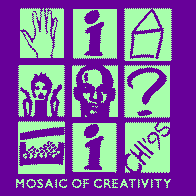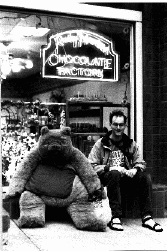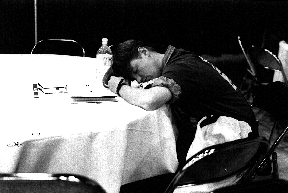Issue
Article
Vol.27 No.4, October 1995
Article
Issue
Issue |
Article |
Vol.27 No.4, October 1995 |
Article |
Issue |

At CHI, SIGCHI's annual conference, around 2,500 attendees come together for a week of activities. These include workshops, tutorials, presentations of both research in progress and research results, exchanges of ideas and face to face meetings with acquaintances old and new.
Student volunteers (SVs) are an integral part of the annual SIGCHI conferences. Without SVs, the conference would become a very different experience for all involved. First, it would be significantly more costly, causing the attendance to drop. Because SVs are volunteers, they are not paid (at least not by monetary means), helping to keep the cost of the conference down. Second, all events would be staffed by paid professionals who have no interest in the content of the conference. SVs have become the lifeblood of the conference, helping the CHI committee members ensure the conference goes smoothly.
Many within the CHI community are aware of the integral role SVs provide during the conference. However, there are probably just as many who are not aware of this importance. As Mark Altom (CHI '94 SVs Co-Chair, CHI '96 Tutorials Co-Chair) says "it wasn't until I served as SV Co-Chair at CHI '94 that I became aware of the SV contribution to the conference. I think that is because the SVs generally do such a good job, that I didn't even notice them!".
As veteran SVs, who have endured more than one CHI conference, the authors have found the rewards are plenty, impacting both our professional and personal lives. When undertaking the writing of this article, it was decided that two goals would be met. The first is a description of the SV experience to encourage possible future SVs. The second is to further an awareness of the importance of CHI conference SVs within the general CHI community.
The authors have been unable to locate any written documentation on the origins of SVs at CHI, so what follows is based on the recollections of past CHI participants. CHI '85 in San Francisco seems to have been the first year for student volunteers. Jarrett Rosenberg was the SV chair. As to where the idea originated, Lorraine Borman remembers seeing SVs at an ACM Computer Science Conference in either '83 or '84. They were wearing t-shirts with a company logo on the back. Their precise status and duties are unknown.
In the ensuing 10 years, SVs have become increasingly central to the successful execution of CHI conferences. Easily identified by their signature t-shirt, which varies from year to year, student volunteers do everything from stuffing the conference bags prior to the beginning of CHI to helping break down the exhibits after the close of the conference.
The creation of the SV program was not motivated by purely financial considerations. From the beginning, the premise was to get students more involved with the CHI community. Lorraine Borman says "I do believe the idea for the SVs was to get students involved, help them make contacts, meet people who they had read about, etc. and also to help the conference function better. It wasn't just the idea of getting `slave labor' as we used to call grad students in the academic world -- far from it."
As the conference has grown, the SVs have grown with it. Paul Henning, CHI Conference Manager, explains just how valuable SVs are to the conference: "They provide a source of cheerful, energetic and incredibly intelligent support on site at the conference that it could not otherwise afford. The students are the primary labor force that helps keep the conference running."
Students from all over the world come to CHI as SVs. Out of a total of 150 SVs at CHI '95, 40 (27%) were from outside the US. By far most of those non-US SVs came from the United Kingdom, but other SVs came from far-away places, including: Sweden, The Netherlands, Denmark, Spain, Ukraine, Switzerland, Italy, Germany, and Austria. The multicultural diversity of the SVs certainly illustrates the international breadth of the CHI community.
Of the 150 SVs, approximately 40% were women; 37% had been an SV before, either at CHI or another conference; roughly 80% were in graduate school, the other 20% were undergraduates; and 45% of the SVs could speak a language other than English.
Each year there are only a limited number of spots available for SVs -- 150 were available for CHI '95. Interested students apply to be an SV by following the instructions found in the call for participation. Usually this entails simply e-mailing an application to the SV chair. Students are assigned to one of the available spots on a first-come first-serve basis. The SV chairs are, of course, free to implement their own policy for selecting the SVs who apply. However, this method seems to have been used for a number of years.
The SV program has become so popular that a waiting list of students is formed for those interested students who do not get one of the initial guaranteed spots. Students who sign up but later determine they cannot attend must resign, thereby enabling students on the waiting list to attend in their place. Steven Pemberton (CHI '95 SVs Co-Chair) reports that the resignation rate for SVs was especially high for non-US students. Many sign up in the hope that they will gather enough money to afford the high cost of travel to the US. When not enough money is found, they must resign.
As discussed above, the CHI community is an international one, so SVs should also come from many segments of the CHI community. Steven Pemberton found that the first-come first-serve policy for selecting SVs actually favored the US students. To maintain the multicultural identity of the CHI community among the SVs, he says "If I were to do it again, I'd reserve 50 places for non-US students." Whether this is a fair number is certainly up to debate. However, some percentage of the total SV population should be set aside for non-US students so that the international CHI student community is also represented at CHI conferences.
Before deciding to become an SV, remember that although the conference registration is waived, there are other costs which must be provided for, whether out of the SVs own pocket or from the SVs school or research funding. SVs must provide their own transportation to and from the conference and must also pay for their hotel. Hotel costs are generally small. The conference rates are lower than the usual room rate and at CHI '95, rooms at the cheapest hotel were held for SV registration prior to release for general CHI attendee reservations. Finally, many SVs share rooms with one another.
When accepted as an SV, the student is placed on an electronic mailing-list along with all of the other SVs. As the conference date gets closer, the SV co-chairs use this list to distribute important information about the conference, the duties involved, and its preparation. SVs also use the list to find roommates to share housing with during the conference, talk about the weather at the conference city, and things to see and do while there.
So what exactly do you do as a student volunteer? An SV is expected to work about 20 hours during the conference. In addition, SVs are expected to attend one of the SV training sessions held just prior to the beginning of the conference; wear the SV t-shirt when working; and come to the tear down session immediately following the close of the last conference session. Other than that, SVs are free to enjoy and participate in the conference.
There are many, many different duties throughout the conference. Most SVs get their share of doing different things. A few jobs, such as signage, may require that some SVs perform that task exclusively throughout the conference. By far the most fun is being able to partake in a variety of different aspects of the conference.
The CHI conference week looks like this:

Student Volunteers Stuff Conference Bags with Proceedings
To give you a feeling for what some of the SV jobs are like, following is a list of job names and their descriptions:
Each day SVs report to the SV lounge to sign-up for jobs for the next day. There are not quite enough jobs in a single day for all of the SVs, so the next day's schedule can fill up by mid-morning. However, there are plenty of jobs to go around throughout the entire week.
On most days, lunch is provided in the lounge for the SVs. SVs that are not working on a particular day, are still welcome to come by and grab lunch. The SV lounge is a good place to hang out, meet other SVs, and make plans for the evening.
There is a lot more to SV life than just working the conference. CHI conferences have become so large that they are held in fairly large cities, which offer many opportunities to explore the city itself, its restaurants, and sights. Many SVs gather in groups at the end of each day and venture into the city for food, exploration, or even dancing.
Enjoying the Denver Shops at CHI '95; Chocolate Anyone?

Finally, after the conference is over all SVs are expected to stay and help tear down the exhibit area. This usually only takes around an hour or two at most. Later that evening is a "Thank you!" party for all the SVs and conference committee members. There is good food, music (sometimes a live band), dancing, and more. This year, since the party was held in an athletic club, many SVs played volleyball and basketball before enjoying the other festivities at the party. At CHI '94 the party was held in the Boston Children's Museum, allowing SVs to enjoy the museum itself.
Being an SV can be a challenge at times. But for the most part the rewards and benefits far outnumber the drawbacks. Here we present the good -- and the bad -- of being an SV. First, the bad!
Working as an SV can be overwhelming at times. Your duties may require that you work extended (or early) hours and some jobs are physically demanding. SVs have been known to catch a nap or two in the SV lounge. Other jobs have significant responsibilities and can be stressful.
SVs must wear the SV t-shirt while working. During SV training the students are advised to wear it "over" another shirt, since it will be worn all week. Since SVs have the shirt on most of the time, other conference attendees are certainly going to ask questions of students when they are not working. This is both good and bad. People expect an SV to know all the answers, which isn't always the case. On the other hand, the SVs get to meet lots of people that way, both their peers and famous researchers in their own area of study.
As an SV, one gets free conference registration, a free tutorial, and a free t-shirt (sure to be a collector's item!), and some free food. However, "the benefits of being an SV", says Marian Williams (CHI '94 SVs Co-Chair and CHI '96 Tutorials Co-Chair, "go far, far beyond the obvious rewards".
By attending a world-class and high-quality conference, SVs see presentations and papers on the forefront of HCI research, technology, and practice. SVs will meet some of the authors of papers being read for classroom or research, and the authors will meet the SVs. Later this can help an SV find employment leads or future collaborative opportunities.
SVs also get a behind-the-scenes look at the operation of a large conference and the opportunity to meet many of the CHI and SIGCHI committee members. This gives SVs an excellent understanding of what is involved in being a committee member. After graduation, the former SV has a fairly clear idea of whether or not being a committee member is their cup of tea.
Other, less professional rewards include meeting other students from around the world and making new friends, free food, travel to a big city, or perhaps another country! All in all, being an SV is a very rewarding experience and many students return in subsequent years.
As previously indicated, one of the many reasons for becoming an SV is to learn if one wishes to become more involved with SIGCHI and perhaps even serve on a future CHI conference committee. Many students attend several CHI conferences as SVs, and a few have continued to be involved with SIGCHI after completing their education. SV programs such as CHI's encourage students to become professionally active in their own fields. Having started while a student, professional activities after graduation are a natural activity.
However, transitioning from being an SV to being a regular conference attendee can be both challenging and frustrating. An SV naturally meets dozens of people every conference day as a part of doing their jobs. Conference attendees tend to jump at the chance to help teach an SV about the field or to serve as a sounding board for SVs ideas. Many of the biggest names in the HCI field make a point of visiting the SV lounge each conference just to meet the current year's SVs. They want to know what the SVs are studying and what they plan on doing when they graduate. So even shy SVs will meet numerous people and begin the important professional activity of networking with their professional peers. While SVs can't help but meet people, regular conference attendees must make a significant effort to meet the same number of people. There is no longer anything singling one out from the other 2500+ conference attendees. It is also a strange experience to go from being an integral part of the conference, working behind the scenes to help make everything go smoothly, to "just" participating in conference activities. This may be one reason why so many SVs decide to become more actively involved on the CHI Conference Committees and the SIGCHI Executive Committee following their SV experience.
The CHI community can learn from the experiences of SVs. Past-SVs have an advantage over other people attending the conference for the first time (as a non-SV) in that they already have some contacts from prior conferences. At CHI '95 there was a deliberate attempt to make first-time attendees feel welcomed into the CHI community by issuing badge stickers that indicated new or previous CHI attendance. By encouraging people who have been part of CHI for a long time to make extra efforts to talk with and include newcomers, first-time attendees begin to make contacts and begin to feel more a part of the CHI community. By letting people know how rewarding it is to help out behind the scenes, perhaps more people will decide to become active in the various SIGCHI and CHI committees.
One last thing to remember is that even once SVs have graduated, many are still relatively new to the world of CHI and might still be looking for direction. To continue bringing both current and recently-graduated students into the CHI community, there are several things we can do. One is a mentoring program where experienced CHI professionals can work with current and/or recently-graduated students to help them get started in their own CHI career. Recent students can also talk with current students about their experiences upon finishing school. At future CHIs, there could be SV alumni reunions, in the evening or as a SIG, where SVs, past and present, can share their experiences and just reminisce about life as an SV.
The authors hope that this column is useful not only to the SIGCHI community, but also to other segments of the ACM community. SV programs are a wonderful way to involve students in their field's professional activities, while providing a benefit to that community in return. Other SIGs are encouraged to implement their own SV programs.
For information about the CHI '96 SV program, see http://www.acm.org/sigchi/chi96/call/students/, or email chi96-students@acm.org.
For more photos of the CHI '95 SV experience, go to
http://www.cwi.nl/~steven/chi95/sv95.html
About the Authors
Pia J. Nielsen is a doctoral student in the Department of Information Science at the Claremont Graduate School, in Claremont, CA, USA, where she doing research in the area of knowledge management and organizational memory. She can be reached at nielsenp@cgs.edu.
G. Bowden Wise is a doctoral student in the Department of Computer Science at Rensselaer Polytechnic Institute, in Troy, NY, USA, where he is doing research on multimodal interfaces. He can be reached at wiseb@cs.rpi.edu.
Karen J. Horwitz is a usability engineer at Lotus Development Corporation. She graduated from Stanford University in Palo Alto, CA, USA, in June 1994 with a B.S. in Human Computer Interaction. She can be reached at khorwitz@ccmail.com.
A Student Volunteer Catching a Nap in the SV Lounge

Issue |
Article |
Vol.27 No.4, October 1995 |
Article |
Issue |